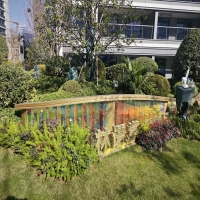Welcome to the website for landscape facilities products and knowledge.
How does the table’s design contribute to its overall aesthetic appeal in outdoor spaces?
A well-chosen outdoor table does far more than simply hold drinks and plates—it serves as the centerpiece of your exterior living area, anchoring the space with personality and purpose. The aesthetic appeal of an outdoor table stems from a harmonious blend of several design elements that work together to create visual and functional harmony.
Material selection fundamentally dictates the table's character. Natural stone slabs, such as granite or slate, impart a sense of timeless, rugged elegance, seamlessly blending with garden landscapes. In contrast, sustainably sourced teak or acacia wood offers warm, organic tones that mature gracefully with weathering. For a contemporary vibe, powder-coated aluminum or synthetic wicker provides clean lines and a palette of modern colors, creating a striking visual statement against green backdrops.
The table's shape is equally critical to its aesthetic impact. A round or oval table fosters intimacy and facilitates effortless conversation, making it ideal for cozy courtyards. Its curved edges soften the hard lines often found in architecture and fencing. Square and rectangular tables, conversely, introduce structure and formality, perfectly framing a long patio or complementing the linear geometry of a home's exterior. The silhouette of the table against the open sky becomes a key part of the outdoor scenery.
Beyond form, design details like the base construction and surface texture add layers of visual interest. An intricately wrought iron base can evoke classic romance, while a minimalist concrete pedestal makes a bold, modern claim. The texture of the tabletop—be it the smooth, cool touch of polished metal, the gentle grain of wood, or the rough-hewn finish of concrete—invites touch and enhances the sensory experience of the outdoors.
Ultimately, the most successful outdoor table designs achieve a delicate balance. They are not merely standalone objects but are thoughtfully integrated into their environment. They complement the home's architectural style, reflect the homeowner's personal taste, and are built to withstand the elements while aging with grace. A table's design, therefore, is not just about aesthetics; it's about creating a focal point that invites gathering, enhances the natural beauty of its surroundings, and transforms an ordinary outdoor area into a curated, inviting sanctuary.
Related search:

Recommendation
Metal and acrylic color-changing combined curtain wall for large-scale public landscape facilities